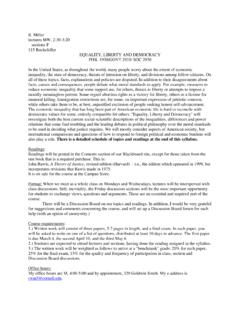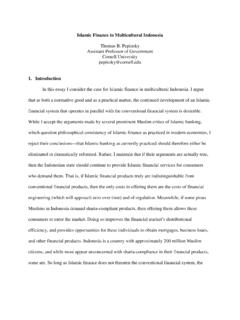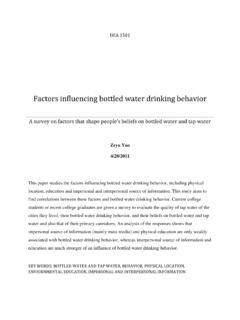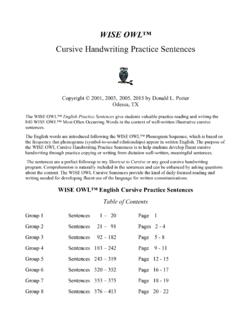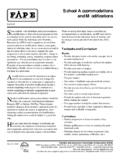Transcription of Fermi’s Golden Rule - Cornell University
1 Chapter 24. fermi 's Golden Rule Introduction In this chapter, we derive a very useful result for estimating transition rates between quantum states due to time-dependent perturbation. The results will be used heavily in subsequent chapters to understand the optical and electronic transport properties of semiconductors. fermi 's Golden Rule Consider an unperturbed quantum system in state | t0 i at time t = t0 . It evolves to the state | ti at a future instant t. The time evolution of the state vector is governed by the unperturbed Hamiltonian H0 according to the time-dependent Schrodinger equation i~ | ti = H0 | t i. ( ). @t If the system was in an eigenstate | t0 i = |0i of energy E0 at time t0 , then the state at a future time di ers from the initial state by a phase factor E0. i (t t0 ).
2 H0 | t0 i = E0 | t0 i =) | ti =e ~ | t0 i. ( ). This is a stationary state; if the quantum state started in an eigentstate, it remains in that eigenstate as long as there is no perturbation. But the eigen-state vector still ro- tates' in time with frequency !0 = E0 /~ in the Hilbert space as indicated schematically 146. Chapter 24. fermi 's Golden Rule 147. in Figure It is called stationary because physical observables of the eigenstate will require not the amplitude, but the inner product, which is h t| ti =h t0 | t0 i. This is manifestly stationary in time. State vectors rotate in time State vectors do not rotate in time Transformation Schrodinger picture Interaction picture Figure : Schrodinger vs. Interaction pictures of time-evolution of quantum state. Now let us perturb the system with a time-dependent term Wt.
3 This perturbation can be due to a voltage applied on a semiconductor device, or electromagnetic waves (photons). incident on a semiconductor. The new Schrodinger equation for the time evolution of the state is i~ | ti = [H0 + Wt ]| t i. ( ). @t In principle, solving this equation will yield the complete future quantum states. In practice, this equation is unsolvable, even for the simplest of perturbations. Physically, the perturbation will scatter' a particle that was, say in state |0i to state |ni. However, we had noted that even in the absence of perturbations, the eigen-state vectors were already evolving with time in the Hilbert space. For example, state vector |0i was rotat- ing at an angular frequency !0 , and state vector |ni at !n . This is shown schematically in the left of Figure It would be nice to work with unperturbed state vectors that do not change in time, as in the right of Figure This calls for a transformation to a vector space that freezes' the time evolution of the unperturbed eigen state-vectors.
4 Such a transformation is achieved by the relation Chapter 24. fermi 's Golden Rule 148. H0. i t | ti =e ~ | (t)i, ( ). where H0 is the Hamiltonian operator. Note that the operator now sits in the exponen- tial, but it should not worry us much. We will see that it is rather useful to have it up there. The reason for this non-obvious transformation is because when we put this into the Schrodinger equation in Equation , we get . i i H0. t i H0. t @ i H0. t i~ H0 e ~ | (t)i + e ~ | (t)i = [H0 + Wt ]e ~ | (t)i, ( ). ~ @t and there is a crucial cancellation, leaving us with @ H0 H0. i~ | (t)i = [e+i ~ t Wt e i ~. t ]| (t)i = W (t)| (t)i ( ). @t H0 H0 H0. where W (t) = e+i ~. t Wt e i ~. t . Can we take the operator e i ~. t from the left to the H0 H0 H0. +i t +i t i t right side as e ~ ? Yes we can, because e ~ e ~ = I, the identity operator.
5 The boxed form of the time-evolution is called the interaction picture, as opposed to the conventional form of Equation , which is called the Schrodinger' picture. Note that if there is no perturbation, Wt = 0 =) W (t) = 0 =) i~ @| @t(t)i = 0. Then, | (t)i = | (t0 )i, and we have managed to find the state vector representation in which the unperturbed eigenvectors are indeed frozen in time. Now lets turn the perturbation Wt on. Formally, the state vector at time t in the interaction representation is obtained by integrating both sides: Z t 1. | (t)i = | (t0 )i + dt0 W (t0 )| (t0 )i, ( ). i~ t0. and it looks as if we have solved the problem. However, there is a catch - the unknown state vector | (t)i appears also on the right side - inside the integral. This is also a re- cursive relation!
6 It reminds of the Brilloiun-Wigner form of non-degenerate perturbation theory. Let's try to iterate the formal solution once: Z " Z #. t t0. 1 1. | (t)i = | (t0 )i + dt0 W (t0 ) | (t0 )i + dt00 W (t00 )| (t00 )i , ( ). i~ t0 i~ t0. and then keep going: Chapter 24. fermi 's Golden Rule 149. Z t Z t Z t0. 1 0 0 1 0 0. | (t)i = | (t0 )i + dt W (t )| (t0 )i + dt W (t ) dt00 W (t00 )| (t0 )i +.. | {z } i~ t0 (i~)2 t0 t0. W 0 | {z } | {z }. W 1 W 2. ( ). We thus obtain a formal perturbation series to many orders. The hope is that the series converges rapidly if the perturbation is small', because successive terms increase as a power law, which for a small number gets even smaller. Let's accept that weak argument now at face value, and we return later to address, justify, and where possible, fix this cavalier approximation.
7 Let | (t0 )i = |0i be the initial state of the quantum system. The perturbation is turned on at time t0 . The probability amplitude for the system to be found in state |ni at time t(> t0 ) is hn| t i. Note the Schrodinger representation! But the transformation from H0. i t i E~n t Schrodinger to interaction picture helps: hn| ti = hn|e ~ (t)i = e hn| (t)i. This implies |hn| 2 = |hn| (t)i|2 - for all eigenstates |ni. Let us make an approxi- t i|. mation in this section and retain only the first order term in the perturbation series. We will return later and discuss the higher order terms that capture multiple-scattering events. Retaining only the terms of Eq. to first order in the perturbation W gives Z t Z t 1 0 0 1 H0 0 H0 0. hn| (t)i hn|0i + dt hn|W (t )|0i = dt0 hn|e+i ~. t Wt0 e i ~.
8 T |0i. ( ). | {z } i~ t0 i~ t0. =0. Let us assume the perturbation to be of the form Wt = e t W representing a slow turn on', with = 0+ , and W = W (r) a function that depends only on space. If = 0, then the perturbation is time-independent. But if = 0+ , then e t0 ! 0 as t0 ! 1. This construction thus e ectively kills the perturbation far in the distant past, but slowly turns it on to full strength at t = 0. We will discuss more of the physics buried inside . later. For now, we accept it as a mathematical construction, with the understanding to take the limit ! 0 at the end. Then, the amplitude in state |ni simplifies: Z t Z t . 1 0 +i H0 0. t t0 i H0 0. t hn|W |0i 0 i En ~. E0. t0 t0. hn| (t)i dt hn|e ~ e W e ~ |0i = dt e e , i~ t0 | {z } | {z } i~ t0. En t0 E0 0. e+i ~ hn| e i ~. t |0i ( ).
9 And the integral over time may be evaluated exactly to yield Chapter 24. fermi 's Golden Rule 150.. Z t i En ~. E0. t t i En ~. E0. t0 t0 i En ~. E0. t t i En E0. t0 t0 e e e e e e dt0 e ~. e = En E0. =. |{z} En E0.. ( ). t0 i ~ + t ! 1. i ~ + . 0. The amplitude then is . En E0 En E0. i ~. t t i ~. t t hn|W |0i e e e e hn| (t)i En E0. = hn|W |0i . ( ). i~ i ~ + (E0 En ) + i~ . The probability of the state making a transition from |0i to |ni at time t is 2 2 2 e2 t |hn| t i| = |hn| (t)i| |hn|W |0i| . ( ). (E0 En )2 + (~ )2. The rate of transitions from state |0i ! |ni is . 1 d 2 . = |hn| (t)i|2 |hn|W |0i|2 e2 t . ( ). |0i!|ni dt (E0 En )2 + (~ )2. Now we take ! 0+ . The third term e2 t ! 1, but we must be careful with the quantity in the bracket. When ! 0, this quantity is 0, except when the term E0 En =.
10 0; then the term seems indeterminate. By making a plot of this function, we can convince ourselves that it approaches a Dirac delta function in the variable E0 En . 2 1 1 1. The mathematical identity lim !0+ x2 + 2. = lim !0+ i [ x i x+i ] = 2 (x), where (..) confirms this: in the limit, the term indeed becomes the Dirac-delta function. Then, using (ax) = (x)/|a|, the rate of transitions is given by 1 2 . |hn|W |0i|2 (E0 En ), ( ). |0i!|ni ~. which is the fermi 's Golden rule. The general form is 2 /~ times the transition matrix element squared, times a Dirac-delta function as a statement of energy conservation. Perturbations oscillating in time Now suppose the perturbation potential was oscillating in time. We will encounter such perturbations frequently, in the form of electron-photon, or electron-phonon interactions.

